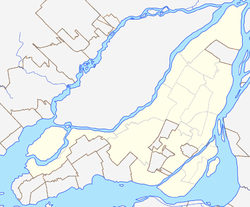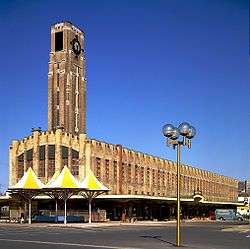Saint-Henri, Montreal
| Saint-Henri | |
|---|---|
| Neighbourhood | |
|
Art deco 23 fire hall, Saint-Henri | |
 Saint-Henri Location of Saint-Henri in Montreal | |
| Coordinates: 45°28′38″N 73°35′11″W / 45.47716°N 73.58651°WCoordinates: 45°28′38″N 73°35′11″W / 45.47716°N 73.58651°W | |
| Country | Canada |
| Province | Quebec |
| City | Montreal |
| Borough | Le Sud-Ouest |
| Established | 1685 |
| Population (2011)[1] | |
| • Total | 15,800 |
Saint-Henri is a neighbourhood in southwestern Montreal, Quebec, Canada, in the borough of Le Sud-Ouest.
Saint-Henri is usually considered to be bounded to the east by Atwater Avenue, to the west by Autoroute 15, to the north by Autoroute 720 and to the south by the Lachine Canal.
Description
Saint-Henri is well known as a historically French-Canadian, Irish and black working class neighbourhood. Often contrasted with wealthy Westmount looking down over the Falaise Saint-Jacques, in recent years it has been strongly affected by gentrification.
The area—historically known as Les Tanneries because of the artisans' shops where leather tanning took place—was named for St. Henry via the Église Saint-Henri, which at one time formed Place Saint-Henri along with the community's fire and police station. The bustle of a nearby passenger rail station was immortalized in the song "Place St. Henri" (1964) by Oscar Peterson.[2]
Saint-Henri is part of the municipal district of Saint-Henri–Petite-Bourgogne–Pointe-Saint-Charles. The borough hall for Le Sud-Ouest is located in a converted factory in Saint-Henri, bearing witness to the borough's industrial heritage.
History

Église Saint-Henri was so named to commemorate Fr. Henri-Auguste Roux (1798–1831), the superior of Saint-Sulpice Seminary. The municipality of Saint-Henri was formed in 1875, joining the village of Saint-Henri and the surrounding settlements of Turcot, Brodie, Saint-Agustin and Sainte-Marguerite into one administrative unit.[3] The municipality was incorporated into the City of Montreal in 1905.[3]
Well-known people from Saint-Henri include strongman Louis Cyr, who served as a police officer there; the Place des Hommes-Forts and the Parc Louis-Cyr are named for him. Celebrated jazz pianist Oscar Peterson grew up in Little Burgundy which is the neighborhood adjacent to Saint-Henri. Stand-up comedian Yvon Deschamps has described the daily struggle of Saint-Henri's citizens with humorous melancholy.
Saint-Henri and Little Burgundy are considered to have a fairly common social makeup. Historically, Saint-Henri was occupied predominantly by European blue-collar workers while Little Burgundy was occupied primarily by African-Canadians who worked on the railroads. Today both neighbourhoods have a population of varied ethnicity and social class, especially in the recent housing developments that have sprouted along the Lachine Canal. A great number of teenagers from neighboring districts attend Polyvalente Saint-Henri and James Lyng High School (English Montreal School Board).
Many of the district's notable Art deco buildings, including Atwater Market and the historic No. 23 fire hall, were designed by Ludger Lemieux.[4][5][6]
The neighbourhood is served by the Lionel-Groulx and Place-Saint-Henri Metro stations.
Depictions in literature and film


The district's working-class character was most memorably recorded by Gabrielle Roy in her novel The Tin Flute (Bonheur d'occasion).
Saint-Henri has been the subject of two National Film Board of Canada (NFB) documentaries, each capturing one day in the life of the district. In 1962 Hubert Aquin directed À St-Henri le cinq septembre (September Five at Saint-Henri). In 2010, director Shannon Walsh and producer Sarah Spring oversaw a crew of sixteen videographers as they followed area residents during one summer's day to make À St-Henri le 26 août, an NFB/Parabola Films co-production inspired by Aquin's cinéma-vérité classic.[7]
Notable people from Saint-Henri
- Pat Burns - former police officer, NHL head coach and TV hockey broadcaster
- Yvon Deschamps - author, actor, comedian and producer
- Louis Cyr - strongman who served as a police officer in Saint-Henri, commemorated with a park, a square, and a statue
See also
Gallery

- Saint-Henri Map
 Saint-Henri in February
Saint-Henri in February
References
- ↑ 2011 Canadian census tracts 4620079 - 4620084
- ↑ Place St. Henri. Retrieved 2015-08-23.
- 1 2 Industrial Architecture of Montreal: Saint-Henri
- ↑ "Saint-Henri Fire Station". Images Montreal. Retrieved 2009-11-16.
- ↑ "Montreal Insites". Heritage Montreal. Retrieved 2009-11-15.
- ↑ "Trois architectes, trois quartiers : Ludger Lemieux (St. Henri), Ernest Cormier (Cité universitaire), Ernest Isbell Barott (St. Antoine)". Montreal: Canadian Centre for Architecture. Retrieved 2009-11-16.
- ↑ Fraser, Malcolm (19 May 2011). "St-Henri revisited". Montreal Mirror. Retrieved 21 May 2011.
External links
| Wikimedia Commons has media related to Saint-Henri. |
- Documentary film about the neighbourhood released in 2011, "St-Henri, the 26th of August"
- Parish oral history of part of Saint-Henri with a number of historical photographs.
- Aquin, Hubert. "September Five at Saint-Henri" (Requires Adobe Flash). Documentary film. National Film Board of Canada. Retrieved 8 June 2011.
- Saint-Henri Historical Society website.
